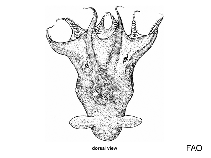Vampyroteuthis infernalis Chun, 1903
Vampire squid| Native range | All suitable habitat | Point map | Year 2050 |

|
| This map was computer-generated and has not yet been reviewed. |
| Vampyroteuthis infernalis AquaMaps Data sources: GBIF OBIS |
Upload your photos
Google image | No image available for this species;
drawing shows typical species in Vampyroteuthidae.
Google image | No image available for this species;
drawing shows typical species in Vampyroteuthidae.
Classification / Names Common names | Synonyms | CoL | ITIS | WoRMS
Cephalopoda | Vampyromorpha | Vampyroteuthidae
Environment: milieu / climate zone / depth range / distribution range Ecology
Pelagic; depth range 100 - 3000 m (Ref. 110525), usually 900 - 1100 m (Ref. 106682). Tropical; 44°N - 35°S, 180°W - 180°E (Ref. 96968)
Distribution Countries | FAO areas | Ecosystems | Occurrences | Introductions
Circumglobal in tropical and temperate waters.
Length at first maturity / Size / Weight / Age
Maturity: Lm ? range ? - ? cm Max length : 13.0 cm ML male/unsexed; (Ref. 96968)
Total length is up to 30 cm (Ref. 96968). One type of a living fossil which showed very little change since it first appeared. The species could turn itself 'inside out' to avoid predators. Inhabits deep waters of open oceans (Ref. 843). Depths range from 600 to 1,200 m. This is a mid-water species. The long filaments in pits between the first two arm pairs may be used to feel for or chemically detect prey. Live animals observed in situ typically orient in the water column with the dorsal mantle surface facing upwards and one filament extended well beyond the arms. Disturbed animals pull the arms and web over their body to take on an inverted shape that exposes the black skin and cirri, on the oral surfaces of the webs. In addition to the large four photophores, this species can produce light on its arm tips and squirt luminous clouds from the arm tips consisting of discrete glowing particles, which can glow for up to 10 minutes (Ref. 96968).
Life cycle and mating behavior Maturity | Reproduction | Spawning | Eggs | Fecundity | Larvae
Members of the class Cephalopoda are gonochoric. Male and female adults usually die shortly after spawning and brooding, respectively. Mating behavior: Males perform various displays to attract potential females for copulation. During copulation, male grasp the female and inserts the hectocotylus into the female's mantle cavity where fertilization usually occurs. Life cycle: Embryos hatch into planktonic stage and live for some time before they grow larger and take up a benthic existence as adults.
Main reference
References | Coordinator | Collaborators
Jereb, P., C.F.E. Roper, M.D. Norman and J.K. Finn. 2014. (Ref. 96968)
IUCN Red List Status (Ref. 130435)
CITES status (Ref. 108899)
Not Evaluated
CMS (Ref. 116361)
Not Evaluated
Threat to humans
Human uses
| FishSource |
Tools
More information
Internet sources
BHL | BOLD Systems | CISTI | DiscoverLife | FAO(Publication : search) | Fishipedia | GenBank (genome, nucleotide) | GloBI | Gomexsi | Google Books | Google Scholar | Google | PubMed | Tree of Life | Wikipedia (Go, Search) | Zoological Record
Estimates based on models
Preferred temperature
(Ref. 115969): 3.4 - 11.6, mean 5.7 (based on 2508 cells).
Price category
(Ref. 80766):
Unknown.



